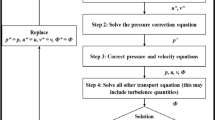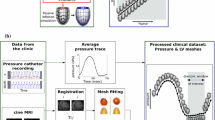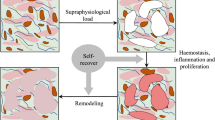Abstract
A methodology is proposed that identifies optimal stent devices for specific clinical criteria. It enables to predict the effect of stent designs on the mechanical environment of stenotic arteries. In particular, we present a numerical study which is based on the interaction of a vascular stent with a patient-specific, atherosclerotic human iliac lesion of type V. The stress evolution in four different tissue components during and after stenting is investigated. The geometric model of the artery is obtained through MRI, while anisotropic material models are applied to describe the behavior of tissues at finite strains. In order to model the observed fissuring and dissection of the plaque under dilation, the undeformed configuration of the arterial wall incorporates two initial tears. The 3D balloon-stent-artery interaction problem is modeled by means of a contact algorithm, which is based on a C 2-continuous surface parametrization, hence avoiding numerical instabilities of standard facet-based techniques. In the simulations three different stent designs are studied. The performance of each stent is characterized by scalar quantities relating to stress changes in the artery, contact forces, and changes in lumen area after stenting. The study concludes by suggesting two optimal stent designs for two different clinically relevant parameters.





Similar content being viewed by others
References
Abè H., Hayashi K., Sato M. (eds) (1996) Data Book on Mechanical Properties of Living Cells, Tissues, and Organs. Springer-Verlag, New York
Auer M., Stollberger R., Regitnig P., Ebner F., Holzapfel G. A. (2006) 3-D reconstruction of tissue components for atherosclerotic human arteries based on high-resolution MRI. IEEE T. Med. Imaging 25:345–357
Bedoya J., Meyer C. A., Timmins L. H., Moreno M. R., Moore J. E. (2006) Effects of stent design parameters on normal artery wall mechanics. J. Biomech. Eng. 128:757–765
Burton H. M., Hunter W. L. (2006) Drug-eluting stents: A multidisciplinary success story. Adv. Drug Deliv. Rev. 58:350–357
W. R. Castaneda-Zuniga, Formanek A., Tadavarthy M., Vlodaver Z., Edwards J. E., Zollikofer C., Amplatz K. (1980) The mechanism of balloon angioplasty. Radiology 135:565–571
Fattori R., Piva T. (2003) Drug-eluting stents in vascular intervention. Lancet 361:247–249
Gasser, T. C., and G. A. Holzapfel. Physical and numerical modeling of dissection propagation in arteries caused by balloon angioplasty. In: Proceedings of the 3rd IASTED International Conference on Biomechanics, edited by M. H. Hamza. Anaheim: ACTA Press, 2005, pp. 229–233.
Gasser, T. C., and G. A. Holzapfel. Modeling plaque fissuring and dissection during balloon angioplasty intervention. Ann. Biomed. Eng. 35:711–723, 2007
Hoher M., Wohrle J., Grebe O. C., Kochs M., Osterhues H. H., Hombach V., Buchwald A. B. (1999) A randomized trial of elective stenting after balloon recanalization of chronic total occlusions. J. Am. Coll. Cardiol. 34:722–729
Holzapfel G. A. (2000) Nonlinear Solid Mechanics. A Continuum Approach for Engineering. John Wiley & Sons, Chichester
Holzapfel G. A. (2006) Determination of material models for arterial walls from uniaxial extension tests and histological structure. J. Theor. Biol. 238:290–302
Holzapfel G. A., Gasser T. C., Ogden R. W. (2000) A new constitutive framework for arterial wall mechanics and a comparative study of material models. J. Elasticity 61:1–48
Holzapfel, G. A., C. A. J. Schulze-Bauer, and M. Stadler. Mechanics of angioplasty: Wall, balloon and stent. In: Mechanics in Biology, edited by J. Casey and G. Bao. New York: The American Society of Mechanical Engineers (ASME) AMD-Vol 242/BED-Vol 46, 2000, pp. 141–156
Holzapfel G. A., Sommer G., Gasser C. T., Regitnig P. (2005) Determination of the layer-specific mechanical properties of human coronary arteries with non-atherosclerotic intimal thickening, and related constitutive modelling. Am. J. Physiol. Heart Circ. Physiol. 289:H2048–2058
Holzapfel G. A., Sommer G., Regitnig P. (2004) Anisotropic mechanical properties of tissue components in human atherosclerotic plaques. J. Biomech. Eng. 126:657–665
Holzapfel G. A., Stadler M., Gasser T. C. (2005) Changes in the mechanical environment of stenotic arteries during interaction with stents: Computational assessment of parametric stent design. J. Biomech. Eng. 127:166–180
Holzapfel G. A., Stadler M., Schulze-Bauer C. A. J. (2002) A layer-specific three-dimensional model for the simulation of balloon angioplasty using magnetic resonance imaging and mechanical testing. Ann. Biomed. Eng. 30:753–767
Humphrey J. D. (2002) Cardiovascular Solid Mechanics. Cells, Tissues, and Organs. Springer-Verlag, New York
Ibrahimbegovic A., Al Mikdad M. (1998) Finite rotations in dynamics of beams and implicit time-stepping schemes. Int. J. Numer. Meth. Eng. 66:781–814
Jang I.-K., Tearney G., Bouma B. (2001) Visualization of tissue prolapse between coronary stent struts by optical coherence tomography. Comparison with intravascular ultrasound. Circulation 104:2754
Kastrati A., Mehilli J., Dirschinger J., Dotzer F., Schühlen H., Neumann F.-J., Fleckenstein M., Pfafferott C., Seyfarth M., Schömig A. (2001) Intracoronary stenting and angiographic results: strut thickness effect on restenosis outcome (ISAR-STEREO) trial. Circulation 103:2816–2821
Kiousis, D. E., T. C. Gasser, and G. A. Holzapfel. Smooth contact strategies with emphasis on the modeling of balloon angioplasty with stenting. submitted.
König A., Schiele T. M., Rieber J., Theisen K., Mudra H., Klauss V. (2002) Influence of stent design and deployment technique on neointima formation and vascular remodeling. Z. Kardiol. 91:98–102
Korelc J. (1997) Automatic generation of finite-element code by simultaneous optimization of expressions. Theor. Comput. Sci. 187:231–248
Lally C., Dolan F., Prendergast P. J. (2005) Cardiovascular stent design and vessel stresses: A finite element analysis. J. Biomech. 38:1574–1581
Laursen T. A. (2002) Computational Contact and Impact Mechanics. Springer-Verlag, Berlin
Lee R. T., Loree H. M., Cheng G. C., Lieberman E. H., Jaramillo N., Schoen F. J. (1993) Computational structural analysis based on intravascular ultrasound imaging before in vitro angioplasty: Prediction of plaque fracture locations. J. Am. Coll. Cardiol. 21:777–782
Liang, D. K., D. Z. Yang, M. Qi, and W. Q. Wang. Finite element analysis of the implementation of a balloon expandable stent in a stenosed artery. Int. J. Cardiol. 104:314–318, 2005
Lyon R. T., Zarins C. K., Lu C. T., Yang C. F., Glagov S. (1987) Vessel, plaque and lumen morphology after transluminal balloon angioplasty Quantitative study in distended human arteries. Arteriosclerosis 7:306–314
Migliavacca F., Petrini L., Massarotti P., Schievano S., Auricchio F., Dubini G. (2004) Stainless and shape memory alloy coronary stents: a computational study on the interaction with the vascular wall. Biomech. Model. Mechanobiol. 2:205–217
Pache J., Kastrati A., Mehilli J., Schühlen H., Dotzer F., Hausleiter J., Fleckenstein M., Neumann F. J., Sattelberger U., Schmitt C., Muller M., Dirschinger J., Schömig A. (2003) Intracoronary stenting and angiographic results: strut thickness effect on restenosis outcome (ISAR-STEREO-2) trial. J. Am. Coll. Cardiol. 41:1283–1288
Piegel L. A., Tiller W. (1997) The NURBS Book 2nd edition. Springer-Verlag, New York
Schulze-Bauer C. A. J., Mörth C., Holzapfel G. A. (2003) Passive biaxial mechanical response of aged human iliac arteries. J. Biomech. Eng. 125:395–406
Schulze-Bauer C. A. J., Regitnig P., Holzapfel G. A. (2002) Mechanics of the human femoral adventitia including high-pressure response. Am. J. Physiol. Heart Circ. Physiol. 282:H2427–H2440
Schwartz R. S., Henry T. D. (2002) Pathophysiology of coronary artery restenosis. Rev. Cardiovasc. Med. 3(Suppl. 5):S4–S9
Serruys P. W., de Jaegere P., Kiemeneij F., Macaya C., Rutsch W., Heyndrickx G., Emanuelsson H., Marco J., Legrand V., Materne P., Belardi J., Sijwart U., Colombo A., Goy J., van den Heuvel P., Delcan J., Morel M. (1994) A comparison of balloon-expandable-stent implantation with balloon angioplasty in patients with coronary artery disease Benestent Study Group. N. Engl. J. Med. 331:489–495
Stary H. C. (1999) An Atlas of Atherosclerosis Progression and Regression. Parthenon, New York
Stolpmann, J., H. Brauer, H.-J. Stracke, R. Erbel, and A. Fischer. Practicability and limitations of finite element simulation of the dilation behaviour of coronary stents. Mat.-wiss. u. Werkstofftechn. 34:736–745, 2003
Taber L. A. (1995) Biomechanics of growth, remodelling, and morphognesis. Appl. Mech. Rev. 48:487–543
Taylor, R. L. FEAP – A Finite Element Analysis Program, Version 7.5 User Manual. Berkeley, California: University of California at Berkeley, 2005.
CUBIT Team. CUBIT 10.0 User’s Manual. Albuquerque, New Mexico, USA: Sandia National Laboratories, 2005
Wang D. L., Wung B. S., Shyy Y. J., Lin C. F., Chao Y. J., Usami S., Chien S. (1995) Mechanical strain induces monocyte chemotactic protein-1 gene expression in endothelial cells Effects of mechanical strain on monocyte adhesion to endothelial cells. Circ. Res. 77:294–302
Weizsäcker H. W., Pinto J. G. (1988) Isotropy and anisotropy of the arterial wall. J. Biomech. 21:477–487
Wentzel J. J., Kloet J., Andhyiswara I., Oomen J. A., Schuurbiers J. C., de Semet B. J., Post M. J., de Kleijn D., Paterkamp G., Borst C., Slager C. J., Krams R. (2001) Shear-stress and wall-stress regulation of vascular remodeling after balloon angioplasty: effect of matrix metalloproteinase inhibition. Circulation 104:91–96
Wolfram Research Inc. Mathematica 5.2. Champaign, Illinois: Wolfram Research, Inc., 2005.
Wriggers P. (2002) Computational Contact Mechanics. John Wiley & Sons, Chichester
Wriggers P., Krstulovic-Opara L., Korelc J. (2001) Smooth C 1-interpolations for two-dimensional frictional contact problems. Int. J. Numer. Meth. Eng. 51:1469–1495
Zhou J., Fung Y. C. (1997) The degree of nonlinearity and anisotropy of blood vessel elasticity. Proc. Natl. Acad. Sci. USA 94:14255–14260
Acknowledgments
The authors are indebted to Martin Auer and Alexander Wulff for their involvements in providing the geometrical models of the artery and the stent, respectively. The support from Boston Scientific Sverige AB providing the Express Vascular LD TM (Boston Scientific) stents is also acknowledged.
Author information
Authors and Affiliations
Corresponding author
Rights and permissions
About this article
Cite this article
Kiousis, D., Gasser, T. & Holzapfel, G. A Numerical Model to Study the Interaction of Vascular Stents with Human Atherosclerotic Lesions. Ann Biomed Eng 35, 1857–1869 (2007). https://doi.org/10.1007/s10439-007-9357-z
Received:
Accepted:
Published:
Issue Date:
DOI: https://doi.org/10.1007/s10439-007-9357-z




